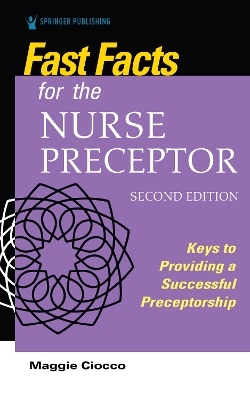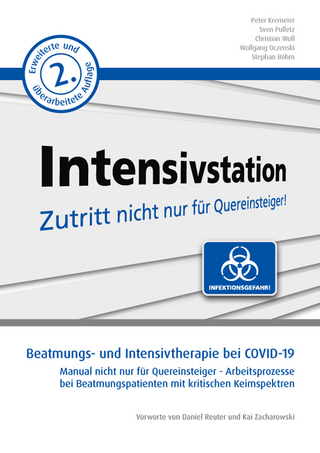
Fast Facts for the Nurse Preceptor
Springer Publishing Co Inc (Verlag)
978-0-8261-3601-5 (ISBN)
- Lieferbar (Termin unbekannt)
- Versandkostenfrei innerhalb Deutschlands
- Auch auf Rechnung
- Verfügbarkeit in der Filiale vor Ort prüfen
- Artikel merken
This quick-access guide for novice nurse preceptors walks through, step-by-step, how to successfully orient new nurses to the hospital environment. Preceptors are key to staff retention, job satisfaction, improved quality of care, patient safety and transition to practice. For the busy novice nurse preceptor who believes they do not have the time or preparation to be a nurse preceptor, Fast Facts for the Nurse Preceptor, Second Edition explains all the requisites for demonstrating, guiding, and mentoring new nurses through the process of delivering safe, evidence-based, patient-centered care. The second edition builds upon the foundation of the first to address more complicated challenges preceptors face. While reviewing the basics like shift organization, prioritization, communication, delegation, and conflict resolution, this orientation guide delineates the essential qualities of a competent preceptor and their primary responsibilities. It discusses the knowledge and skills a successful preceptor must impart to new nurses while acclimating to a variety of teaching and learning styles. Chapters discuss how to recognize the warning signs of a struggling preceptee, work through a preceptee's 'transition shock,' and help new nurses to develop critical thinking skills. Abundant case studies highlight common and challenging precepting situations.
New to the Second Edition:
Updated with FIVE completely new chapters:
Selection, Education, and Retention of the Preceptor
Preceptee Learning and Preceptor Teaching Styles
The Challenging Student
Precepting the Accelerated BSN and Advanced Practice Nurse (APRN)
The Unsafe Preceptee and How to Avoid 'Failure to Fail'
Key Features:
Helps preceptors to serve as excellent role models, mentors, and teachers for new nurses
Offers quick-access, step-by-stop guidance with short paragraphs and bulleted information
Uses case studies to highlight both common and challenging precepting scenarios
Includes evidence-based content throughout
Contains competency assessment and evaluation forms
Maggie Ciocco, MS, RN, BC is currently a nursing program advisor for the W. Cary Edwards School of Nursing at Thomas Edison State College in Trenton, New Jersey. She has over 25 years of experience in nursing education, including as a preceptor, mentor, staff development instructor, orientation coordinator, nursing lab instructor, and clinical instructor. Ms. Ciocco received her master of science in nursing from Syracuse University, her bachelor of science in nursing from Seton Hall University and her associate degree from Ocean County College in Toms River, New Jersey. She has been an American Nurses Credentialing Center board-certified medical-surgical nurse for over 20 years. Throughout her years as an educator, she has established preceptorship programs in acute, subacute, and long-term care settings. She is a member of the National League for Nursing. Ms. Ciocco was awarded the Sigma Theta Tau-Lambda Delta chapter Hannelore Sweetwood Mentor of the Year award in 2012. She is the author of Fast Facts for the Medical-Surgical Nurse: Clinical Orientation in a Nutshell, published by Springer Publishing Company in 2014.
Dedication
Foreword by Linda J. Hassler, MS, RN, GCNS-BC, FNGNA
Preface
PART I INTRODUCTION TO THE ROLE OF THE PRECEPTOR
Chapter 1. Preceptorship in a Nutshell
Chapter 2. Selection, Education and Retention of the Preceptor
Chapter 3. Preceptee Learning and Preceptor Teaching Styles
Chapter 4. The Challenging Student
Chapter 5. Critical Thinking Skills
Chapter 6. Organizing the Clinical Day
PART II COMPONENTS OF EFFECTIVE PRECEPTORSHIP
Chapter 7. Prioritization and Communication
Chapter 8. The Value of Feedback
Chapter 9. The Art of Delegation
Chapter 10. Precepting the Accelerated BSN and Advanced Practice Nurse (APRN)
Chapter 11. Recognizing and Helping the Preceptee Who Is Struggling
Chapter 12. The Unsafe Preceptee and How to Avoid “Failure to fail”
PART III PREPARING THE PRECEPTEE FOR THE FUTURE
Chapter 13. Conflict Resolution and Bullying in Nursing
Chapter 14. Helping the Preceptee Deal with Reality Shock
Chapter 15. Preparing for the Future
PART IV PROBLEM SOLVING AND CLINICAL TOOLS
Chapter 16. Preceptorship Competency Forms and Clinical Tools
Chapter 17. Concerns of the Preceptor & Case Studies
Bibliography
Index
| Erscheinungsdatum | 28.08.2020 |
|---|---|
| Reihe/Serie | Fast Facts |
| Zusatzinfo | 1 illustration |
| Verlagsort | New York |
| Sprache | englisch |
| Maße | 127 x 203 mm |
| Gewicht | 333 g |
| Themenwelt | Pflege ► Fachpflege ► Anästhesie / Intensivmedizin |
| Medizin / Pharmazie ► Pflege ► Pflegemanagement / Qualität / Recht | |
| Pflege ► Studiengänge ► Pflegewissenschaft | |
| ISBN-10 | 0-8261-3601-X / 082613601X |
| ISBN-13 | 978-0-8261-3601-5 / 9780826136015 |
| Zustand | Neuware |
| Haben Sie eine Frage zum Produkt? |
aus dem Bereich


